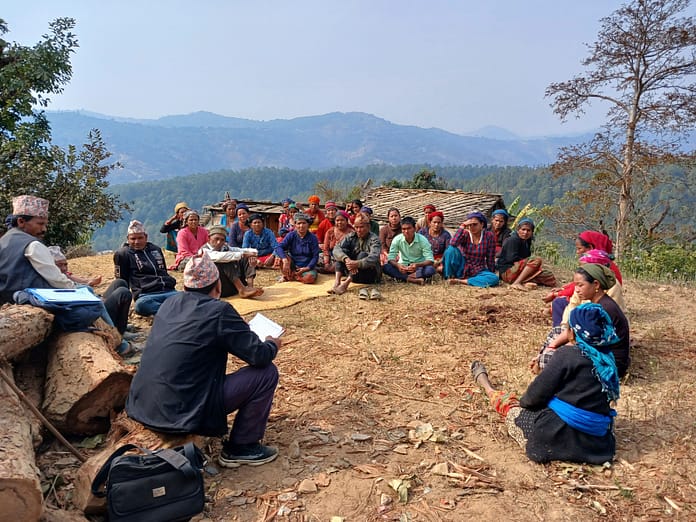Giriraj Amarnath, Research Group Leader – Water Risks and Development Resilience (WRDR)

Photo: IWMI
The recently published World Water Development Report 2020 (WWDR 2020) highlights current impacts and anticipated future risks associated with extreme weather events, and the need for sustainable solutions for climate change adaptation (CCA) and disaster risk reduction (DRR). Scientists at the International Water Management Institute (IWMI) were invited to contribute to a number of chapters in WWDR 2020, including chapter 4 (Water-related extremes and risk management).
Water-related natural disasters are major impediments to human security and sustainable socioeconomic development. Climate change has made extreme weather events more severe by altering their frequency, timing, intensity and duration. Around 74% of all natural disasters between 2001 and 2018 were related to water. According to EM-DAT, the international disaster database, the past 20 years have seen the total number of deaths caused by floods and droughts exceed 166,000 with these extreme weather events also affecting over three billion people and causing economic damage amounting to approximately USD 700 billion. Without proper adaptation hundreds of millions of people will be at greater risk of hunger, disease, energy shortages and poverty due to water scarcity, pollution or flooding.
At IWMI, we are working under the CGIAR Research Programs (CRPs) on Climate Change, Agriculture and Food Security (CCAFS) and Water, Land and Ecosystems (WLE), together with the Indian Council of Agricultural Research (ICAR) and Japan’s Ministry of Agriculture, Forestry and Fisheries (MAFF), to increase the resilience of South Asia’s smallholder farmers to climate shocks by promoting integrated disaster management and improving water management.
Increasing resilience
Since 1900, more than 11.7 million people have died and more than 2.7 billion have been affected as a consequence of drought, more than the loss and damage caused by any other natural hazard (EM-DAT – accessed on March 21, 2020). With the aim of helping farmers affected by drought, IWMI launched the South Asia Drought Monitoring System in 2016. The system allows national authorities to assess exactly when and where disaster relief efforts are needed. Every eight days it publishes detailed maps showing drought severity across Afghanistan, Bangladesh, Bhutan, India, Nepal, Pakistan and Sri Lanka. The maps depict seven categories, from healthy vegetation to extreme drought, through analysis of historical satellite data. Drought relief can then be deployed more effectively. IWMI-led efforts to expand applications of technology to drought preparedness are underway in Southern Africa, the Middle East, and Southeast Asia.
IWMI’s efforts to support nations and regions prepare for climate shocks involve enhancing farmers’ resilience. In recent years, the Institute developed an index-based flood insurance (IBFI) product to compensate farmers whose crops were ruined as a result of floods (see chapter 4 in WWDR 2020). The technology uses satellite data and modeling tools to estimate when the depth and duration of flooding exceeds predefined limits, triggering automatic payouts. Between 2017 and 2019, the IBFI scheme supported insurance payouts in India (USD 22,000) and Bangladesh (USD 31,500) to 1,306 out of 2,300 eligible farming households, to increase their resilience to floods and minimize their vulnerability to natural hazards.
A new trial seeks to build on the success of IBFI by bundling SMS-based weather information and advice on crop and water management methods and fertilizers together with the insurance product. The trial covered 1,000 households with 450 benefitting from a total insurance payout of approximately USD 12,500.
We must balance hard (structural) and soft (policy instruments) approaches by enhancing water storage, building climate-proof infrastructure, improving crop resilience, forecasting, early warning systems and strengthening policies for greater climate investments in regions of priority. One such innovation to address the dual challenges of floods and groundwater depletion is ‘Underground Transfer of Floods for Irrigation’ (UTFI), which involves targeted recharging of aquifers using excess wet season flows to protect lives and assets downstream while also boosting agricultural productivity in the region.
Looking ahead, our focus at IWMI will be to mainstream climate analysis, and planning and investment to identify future climate finance opportunities which are aligned to the nationally determined contributions (NDCs) supported by the Green Climate Fund, World Bank and others. The aim will be to push over USD 100 billion in financing per year through green bonds, subnational climate funds and public-private partnerships to meet both the climate and water goals for sustainable water management (See chapter 12 in WWDR 2020).
IWMI recently announced a partnership with Digital Earth Africa which will aggregate petabytes and decades worth of satellite data to build applications that will address some of the big challenges in water management and climate adaptation. We need to promote more and new knowledge and solutions to build resilient societies, and maximize the synergies between CCA and DRR. With an increasing understanding of how we can capitalize on technologies such as artificial intelligence (AI), the Internet of things, big data platforms, modeling tools and remote sensing technologies, we can significantly improve environmental monitoring, flood forecasting and early warning.















